Nils Dardel
Nils Dardel (full name Nils Elias Kristofer von Dardel, sometimes known as Nils de Dardel) was a 20th-century Swedish Post-Impressionist painter, grandson to famous Swedish painter Fritz von Dardel.[1]
Nils Dardel | |
|---|---|
 Nils Dardel in Tokyo 1917 | |
| Born | Nils Elias Kristofer von Dardel 25 October 1888 |
| Died | 25 May 1943 (age 54) New York City |
| Nationality | Swedish |
| Alma mater | Royal Swedish Academy of Arts |
| Notable work | Den döende dandyn |
| Style | Post-Impressionism |
| Spouse | Thora Dardel |
Biography

Dardel was born in Bettna, Södermanland, Sweden in 1888. He studied at the Royal Swedish Academy of Arts in Stockholm[1] between 1908–1910. Some of his most famous paintings are Den döende dandyn, Crime Passionnel, Svarta Diana and John blund.
Family life
Nils Dardel was born into the Swedish noble family von Dardel, son of the landowner Fritz August von Dardel and Sofia Matilda Norlin. His grandfather was the Swedish painter Fritz von Dardel, adjutant to the later king Charles XV of Sweden and member of the Royal Swedish Academy of Arts in Stockholm,[2] where Nils later studied between 1908–1920, and of which he eventually became a member in 1934.[3]

In 1919, he proposed to Nita Wallenberg, but her father, a Swedish diplomat, disapproved of Dardel and the marriage was not to be. This was linked closely to the creation of his work Exekution (Execution), which is said to be symbolic of the rejection. [4]
Nils Dardel married the author Thora Dardel (1899–1995 – née Klinckowström), which marriage lasted between 1921–1934. Together they had a daughter Ingrid von Dardel (1922–1962) who like her father became an artist. Both her sons Henry Unger (born 1945 – father Gustav Unger) and Nils Ekwall (born 1954 – father Lage Ekwall) in turn were also active Swedish artists.[5][6][7]
After the marriage to Thora, sometime in the 1930s Nils met Edita Morris (1902–1988, née Toll), a Swedish writer with whom he shared his remaining life.[1] - though she remained married to Ira Victor Morris.
Paris

After studying in Sweden he did as many of his contemporaries and traveled to Paris around 1910 (such as Leander Engström, Isaac Grünewald, Einar Jolin, and Sigrid Hjerten who all became students of Henri Matisse). Dardel primarily took inspiration from the Fauvists with their pure palette, the Post-Impressionists, as well as Japanese woodcuts. Dardel also made a brief foray into Cubism, and painted a few cityscapes in the style.[8]
Post-Impressionism
Dardel explored Pointillism, using strong colors together with very clear motifs. Begravning i Senlis (Funeral in Senlis) from 1913 typifies this style and was painted while Dardel was visiting a staying in the medieval town of Senlis. Another early painting was the portrayal German art dealer Alfred Flechtheim. Over the course of Dardel's life, he primarily painted humans, concentrating on portraiture or paintings of groups of people.[8]
Ballets Suédois

After living in Paris for three years, Dardel and Rolf de Maré became friends. Maré would later create the Ballets Suédois, which performed in Paris between 1920 and 1925. The friendship benefited Dardel as Maré was able to act as a benefactor for Dardel's art, and the duo is also claimed to have been fruitful for Maré's dance company.[8]
In the early 1920s, Dardel created a number of works based upon stage sets, and these have been likened to sketches of drama or film. Dardel also created the stage sets for Midsummer Wake (music by Hugo Alfvén), and Maison de Fous (a dance drama with compositions by Viking Dahl). Crime passionnel (Crime of Passion) from 1921 is typical of Dardel's paintings from this era.[8]
Travels
.png.webp)
Nils was a prolific traveler, picking up influences and motives from different countries.
Later years
Dardel lived a nomadic life, traveling far and wide without ever really settling down. Many of his portraits are of people and places whom he met along his travels. He was known to be self-destructive.[8]
Not exceptionally appreciated in his lifetime, his breakthrough in Sweden came simultaneously to the breaking out of World War II in Europe, at the time when Liljevalchs konsthall displayed a retrospective of Dardel's life and works.[8]
Legacy

Nils died in New York City in 1943,[8] and was buried in Ekerö cemetery outside of Stockholm.[9]
His works are on display in a number of museums and galleries including Nationalmuseum, Göteborgs konstmuseum, Malmö konstmuseum, Nasjonalgalleriet and Waldermarsudde. His works Självporträtt (Self-portrait) and Visit hos en excentrisk dam (Visit at an eccentric lady) were featured by the Swedish Postal-works 1988 stamp series Svenska konstnärer i Paris (Swedish artists in Paris).
His 1918 work Den döende dandyn (The dying dandy) was sold twice at record prices at Bukowskis in Stockholm; first in 1984 at 3,4 million kronor and again in 1988 for the then termed sensational 13 million kronor.[10] Simultaneously the image took on an iconic role within the 1980s Swedish gay movement. His works came to be analyzed under the budding field of gender-studies, and the ambivalence of the sex of his characters were topic of study.[11]

Dardel's work Vattenfallet (or the Waterfall) sold for 25 million kronor in 2012 and was to date the most expensive modernist Swedish painting ever sold. The buyer was an undisclosed individual. The record in turn supplanted the earlier record held by the Dying Dandy.[12]
Selected works
1900s
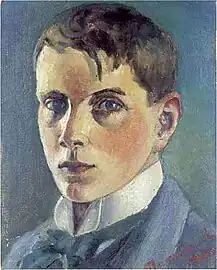 Self-portrait
Self-portrait
1906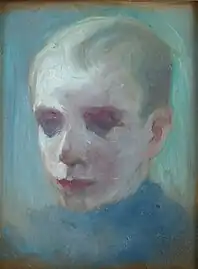 Gosshuvud
Gosshuvud
1908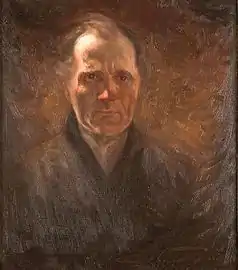 Mansporträtt
Mansporträtt
Portrait of a man
1908 Torparflicka
Torparflicka
Farm girl
1909
1910s
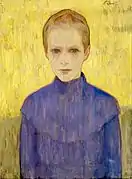 Flicka i blå klänning
Flicka i blå klänning
Girl in blue dress
1910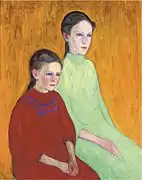 Två flickor
Två flickor
Two Girls
1911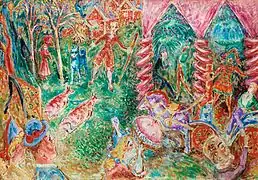 Turisthotellet i Rättvik
Turisthotellet i Rättvik
Tourist hotel in Rättvik
1915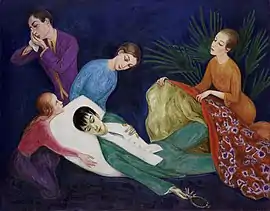
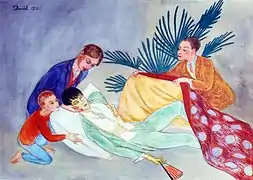 Den döende dandyn
Den döende dandyn
(1st version)
1918
1920s
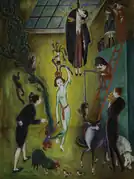 Visit hos excentrisk dam
Visit hos excentrisk dam
1921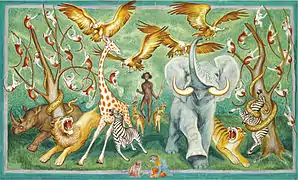 Svarta Diana
Svarta Diana
Black Diana
1929%252C_1922_-_Hallwylska_museet_-_22229.tif.jpg.webp) Drömmar och fanstasier #1
Drömmar och fanstasier #1
Dreams and fantasies
1922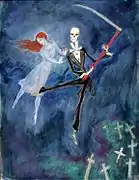 En dans med döden
En dans med döden
A dance with Death
1920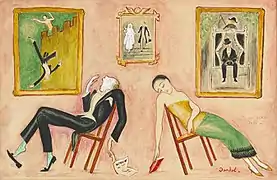 Familjeidyll
Familjeidyll
Family idyll
1923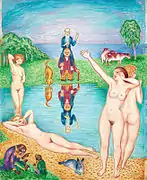 Return to the Playgrounds of Youth
Return to the Playgrounds of Youth
1924
1930s
 Marthe
Marthe
1930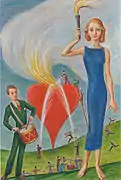 Ett hjärta i brand
Ett hjärta i brand
A heart in flames
ca. 1930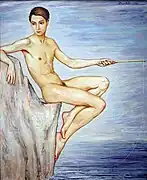 Fiskaren
Fiskaren
The angler
1931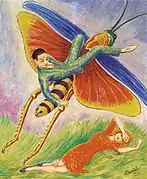 Gräshoppan
Gräshoppan
The Grasshopper
1931 Den bortrövade ormen
Den bortrövade ormen
ca. 1931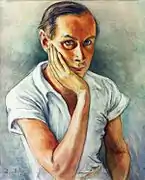 Autoportrait
Autoportrait
1935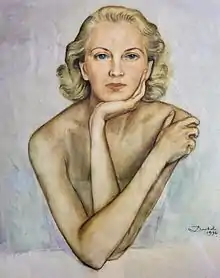 Edita Morris
Edita Morris
1936
1940s
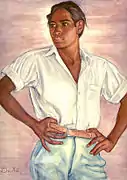 Mexican boy
Mexican boy
~1940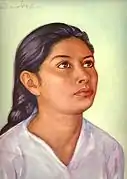 Mexican girl
Mexican girl
~1940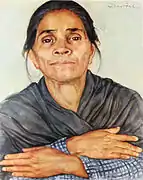 Mexikansk kvinna med korslagda händer
Mexikansk kvinna med korslagda händer
Mexican woman with crossed hands
~1940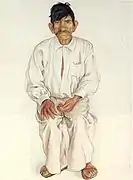 Hustrumördaren
Hustrumördaren
The wife murderer
~1940 Mexican girl
Mexican girl
~1940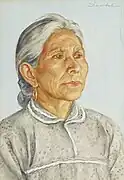 Gammal mexikansk kvinna
Gammal mexikansk kvinna
Old Mexican lady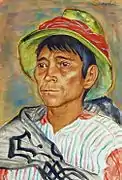 Mexikansk Indian
Mexikansk Indian
Further reading
- Nils von Dardel, in Moderna museet – The Book, ed. C. Widenheim et al., Stockholm, Moderna Museet, 2006 ISBN 9789171006967
- Nils Dardel – and the Modern Age by John Peter Nilsson et al., Moderna Museet, 2014 ISBN 9789186243586
- (in Swedish) Nils Dardel – I skuggan av dandyn, Halmstad: Mjellby Konstmuseum 2012 ISBN 9789198035117
- (in Swedish) En bok om Nils Dardel, by Thora Dardel, Bokförlaget Cordia, 2nd ed. 1995 ISBN 9170851506
- Russian-language site, with numerous Nils Dardel paintings
References
- "Nils Dardel – Short biography". Dardel.info. Retrieved 21 June 2015.
- Blått blod och liljevita händer: en etnologisk studie av aristokratiska kvinnor 1850-1900, Angela Rundquist, Carlsson, 1989, pp. 318-319, 321-322, 382
- Nils Dardel: i skuggan av dandyn; [denna publikation åtföljs av en utställning på Mjellby Konstmuseum. Halmstad: Mjellby Konstmuseum. 2012. p. 67. ISBN 9789198035117.
- Nils Dardel: i skuggan av dandyn; [denna publikation åtföljs av en utställning på Mjellby Konstmuseum. Halmstad: Mjellby Konstmuseum. 2012. p. 16. ISBN 9789198035117.
- Henry Ungers biografi Archived 20 June 2013 at the Wayback Machine Henry Unger webbplats. Åtkomst 6 januari 2013.
- EKWALL, LAGE E O, direktör, Alstad i Vem är Vem? / Skåne, Halland, Blekinge 1966 / s 205.
- Nils Ekwall Officiell webbplats. Åtkomst 6 januari 2013.
- Widenheim, Cecilia, ed. (2004). Moderna Museet – The Book (2nd printing ed.). Stockholm: Moderna Museet. Nils von Dardel. ISBN 9789171006967.
- Göran Åstrand: Känt och okänt på Stockholms kyrkogårdar (Ordalaget Bokförlag 1998) sid.40 ISBN 91-973128-2-7
- "Den döende dandyn under klubban". Retrieved 21 June 2015.
- Nils Dardel: i skuggan av dandyn; [denna publikation åtföljs av en utställning på Mjellby Konstmuseum. Halmstad: Mjellby Konstmuseum. 2012. pp. 7–9. ISBN 9789198035117.
- "Rekordpris på tavla av Dardel – DN.SE". Dagens Nyheter. 24 October 2012. Retrieved 27 June 2015.